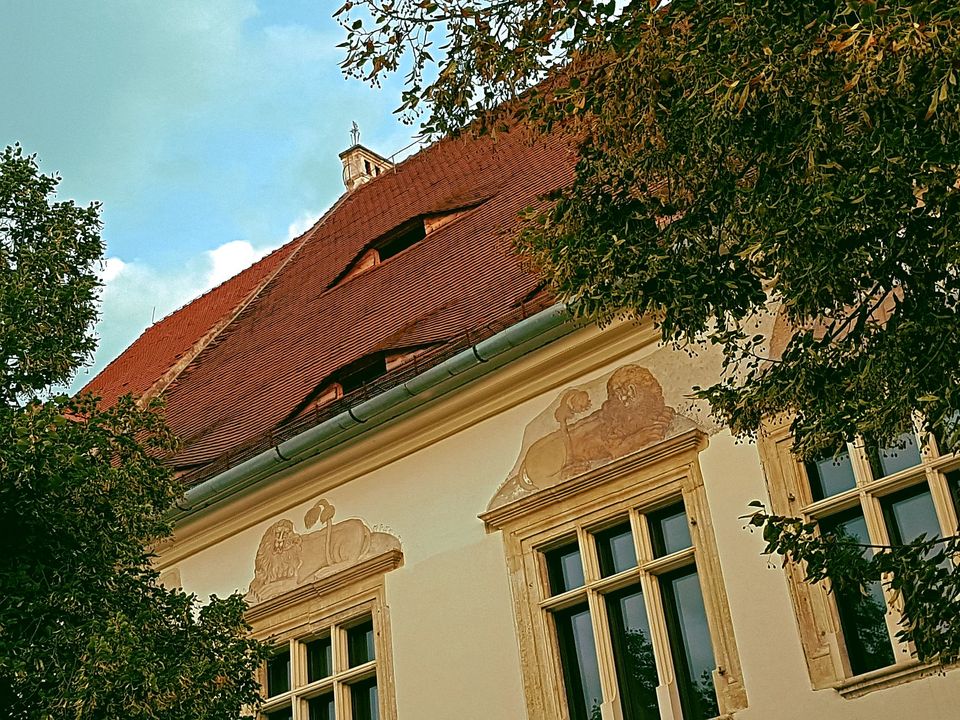
Tour of the frescoes and sculptures of great artistic value
Sibiul este bogat în istorie, iar asta se vede și astăzi, la o simplă plimbare pe străzile orașului. Pentru a-l descoperi mai ușor, împreună cu proiectul Orașul Artiștilor* vă ghidăm în câteva locații cheie unde puteți admira fresce și sculpturi cu valoare artistică deosebită.
____
Orașul Artiștilor este un proiect anual ce transformă un colț din Piața Mică într-o galerie de artă în plină stradă, deschisă timp de 126 de zile, zilnic, între orele 11:00-22:00.
The statue of Georg Daniel Teutsch (Huet Square)
From the Small Square we cross the Bridge of Lies and we reach Huet Square watched over by the imposing statue of Georg Daniel Teutsch on the Southern part of the Evangelical Church. He was one of the leading figures of Sibiu who fought to preserve the Saxon nation and Transylvanian culture. The figure is standing dressed in clerical clothing holding the Bible in his left hand while his right hand is leaning on a colonnette on which there are documents that symbolize the medieval freedoms of the Saxons.
The Statue of St. John of Nepomuk (Large Square, no. 2)
The Large Square is the next place where we can find 3 landmarks of local history. In 1743, during the construction of the Roman – Catholic Church, the Statue of St. Nepomuk was also created as a symbol of the Catholic Counter-Reformation.
Initially, the statue was placed under the tower of the Roman-Catholic Church and in 1734 it was moved to the Large Square. In the words of a chronicler of that time, the statue looked “ridiculous” in that spot and it was “mocked”. The statue would remain in the square until 1948 when it was taken down from its pedestal. Finally, in 1988, the Roman-Catholic Parish symbolically paid 1 leu for the entire ensemble and brought the statue back to the inner courtyard of the Parish in the Large Square. At the end of this odyssey, the statue was restored.
Haller House (Large Square, no. 10)
The Haller House is close by and on its frontispiece is the Haller family coat of arms. Among its architectural elements, the facade is particularly striking with windows that have stone framing and there are also mural paintings at the top of the house representing a series of lions. These were discovered during the rehabilitation works that took place in 2006.
Czekelius House (Large Square, no. 16)
Also situated in the Large Square, Czekelius House is a good place to stop on our tour. Over time, the house belonged to different families including the Czekelius, Reussner, Weidner and Misselbacher family. The house is an ensemble of two different buildings that were connected at the end of the last century. The portal was created by Elias Nicolai, the most important sculptor in Transylvania during the 17th century.
The House with Caryatids (Mitropoliei Street, no. 13)
We leave the Large Square and we head towards Mitropoliei Street on which we will discover 2 objectives. “The House with Caryatids” is built in the Late Baroque style and it is part of the imposing complex of buildings constructed after the Brukenthal Palace, which can be found in the main square of the city. The Caryatids are the statues that decorate the portal. Also known as the “stone virgins”, they are placed on high pedestals. These sculptures are very heavy and that is why most researchers believe they were created by a journeyman of Simon Hoffmeyer, the one who made the Atlantes of Brukenthal Palace.
Müller House (Mitropoliei Street, nr. 26)
The painting on the facade of Müller House is of a Hungarian cognac from the beginning of the 20th century. The house itself dates back to the 16th century. At the end of the 19th century the building was used by the army and in this house lived Dr. Daniel Czekelius, the manager of the hospital, the father of architect Otto Czekelius who spent his childhood in this house.
The Atlantes of ASTRA Library (G. Barițiu Street, no. 5)
At the end of Mitropoliei Street we reach the site of ASTRA Library. Here, the main access gate is guarded by two half figures of Atlantes and above the entrance there are two frames decorated with garlands. The two statues stand on one side and the other of the entrance represented by a rectangular door with several panels and an overhead light.
Madonna and Child Fountain (Dealului Street)
Another stop on the frescoes and sculptures tour is the fountain on Dealului Street built at the initiative of the magistrate of the Town of Sibiu and placed in 1905 in this square. In the middle of the fountain there is the statue of a woman dressed in a Roman fashion holding her baby. The woman is portrayed sitting on a group of rocks and the way her dress falls indicates movement in this sculpture. The dress is held by only one strap. Her hair is also made in the same Roman style. The water flows from a cup that she is holding in her left hand. The child is portrayed nude to suggest purity. Art critics believe that the statue is a representation of the Madonna with Child.
Electrical transformer building (Cetății Street)
We end the tour with a recent, modern, street art point of interest. At the exit of Cazarma 90 parking lot there is a work of street art decorating the “Sadu I Transformer”. The artist’s intention was to transform the location into the Tower of Energeticists with a direct connection to the mark that electricity has left on the community. The Sadu I Transformer is representative in this field because it was the first of its kind in Romania.